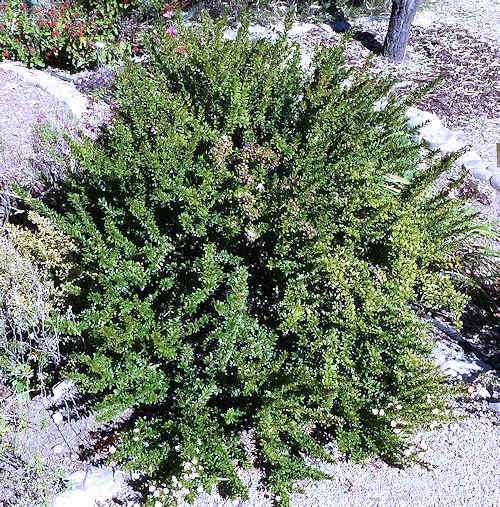Growing Myrtus communis:
Myrtle
Description
Form: Shrub.
Lifespan: Over 100 years.
Leaf retention: Evergreen.
Growth rate: Slow to moderate.
Mature Size: 8-12' (2.4-3.7m) high and as wide.
Flowers: White, five petals, white stamens with yellow-tips, sweetly fragrant. The flowers and buds are edible.
Bloom: Spring. This plant will also bloom in the fall, if left untrimmed, but flowers and buds will be killed by an early frost.
Fruit: Blue-black when ripe, containing several seeds, edible. There is a cultivar with amber-yellow fruit. The fruit drops from the stem after becoming ripe. It may stain concrete, brick or stone.
Leaves: Green, lance-shaped, smooth edges, aromatic when bruised or crushed, edible.
Stems: New shoots are reddish, older stems are tan and develop a flaky bark as they age.
Roots: No surface roots.
Wildlife: The flowers attract bees. The berries attract birds. The foliage is deer resistant.
Toxic / Danger: No.
Origin: Mediterranean, Middle East.
Form: Shrub.
Lifespan: Over 100 years.
Leaf retention: Evergreen.
Growth rate: Slow to moderate.
Mature Size: 8-12' (2.4-3.7m) high and as wide.
Flowers: White, five petals, white stamens with yellow-tips, sweetly fragrant. The flowers and buds are edible.
Bloom: Spring. This plant will also bloom in the fall, if left untrimmed, but flowers and buds will be killed by an early frost.
Fruit: Blue-black when ripe, containing several seeds, edible. There is a cultivar with amber-yellow fruit. The fruit drops from the stem after becoming ripe. It may stain concrete, brick or stone.
Leaves: Green, lance-shaped, smooth edges, aromatic when bruised or crushed, edible.
Stems: New shoots are reddish, older stems are tan and develop a flaky bark as they age.
Roots: No surface roots.
Wildlife: The flowers attract bees. The berries attract birds. The foliage is deer resistant.
Toxic / Danger: No.
Origin: Mediterranean, Middle East.
Cultivation and Uses
USDA hardiness zones: 8-11.
Heat tolerant: Yes.
Drought tolerant: Yes.
Sun: Full sun.
Soil: Well draining, low in organic content, pH 6.1-8.3 (slightly acidic to somewhat alkaline). This plant is salt tolerant.
Water after becoming established: Deep water once a month. The soil must dry out between waterings. Myrtle is prone to root rot in wet soil.
Mulch: Spread a thick layer of organic mulch under the plant to reduce soil temperature and moisture loss in summer.
Planting: Dwarf cultivars will grow in containers.
Prune: In the first two years, prune to shape the overall plant structure. In following years, trim the plant after its fruit has dropped to encourage denser leaf growth. Myrtle is tolerant of frequent clipping and can be used as a hedge or for topiary.
Litter: Low.
Propagation: Pre-soaked seed, cuttings.
Uses: Ornamental, hedge, edible spice. The berries are eaten raw; the flavor is more intense when the plant grows in a hot climate. When used dried and whole, the berries add a peppery note to cooked foods such as pork, and are used to flavor an alcoholic drink. The dried berries and flowers are used to flavor sauces and syrups. The dried leaves are used as a substitute for bay leaves in savory cooked dishes. The fresh flowers are added to salads.
USDA hardiness zones: 8-11.
Heat tolerant: Yes.
Drought tolerant: Yes.
Sun: Full sun.
Soil: Well draining, low in organic content, pH 6.1-8.3 (slightly acidic to somewhat alkaline). This plant is salt tolerant.
Water after becoming established: Deep water once a month. The soil must dry out between waterings. Myrtle is prone to root rot in wet soil.
Mulch: Spread a thick layer of organic mulch under the plant to reduce soil temperature and moisture loss in summer.
Planting: Dwarf cultivars will grow in containers.
Prune: In the first two years, prune to shape the overall plant structure. In following years, trim the plant after its fruit has dropped to encourage denser leaf growth. Myrtle is tolerant of frequent clipping and can be used as a hedge or for topiary.
Litter: Low.
Propagation: Pre-soaked seed, cuttings.
Uses: Ornamental, hedge, edible spice. The berries are eaten raw; the flavor is more intense when the plant grows in a hot climate. When used dried and whole, the berries add a peppery note to cooked foods such as pork, and are used to flavor an alcoholic drink. The dried berries and flowers are used to flavor sauces and syrups. The dried leaves are used as a substitute for bay leaves in savory cooked dishes. The fresh flowers are added to salads.
Comments
This plant is a member of the Myrtle family (Myrtaceae). A dwarf cultivar is shown.
Do you have additional information or a different experience for these plants that you would like to share? Email info@GardenOracle.com. All contributions are welcome and appreciated.
This plant is a member of the Myrtle family (Myrtaceae). A dwarf cultivar is shown.
Do you have additional information or a different experience for these plants that you would like to share? Email info@GardenOracle.com. All contributions are welcome and appreciated.



Latest update: September, 2024
© 2008-2025 by GardenOracle.com

